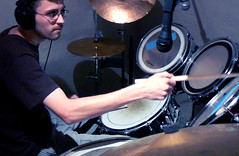B. Thomas Cooper
Editor

Recording drums and percussion instruments can be tricky at times. Every sound engineer has his own story to tell. Noisy symbols, poorly tuned drum heads, questionable room acoustics etc. All can contribute to the chaos, a kind of sonic dysentery. We can't actually cure the disease, but we can treat the symptoms.
The underlying problem can be attributed to those pesky transients. No, not the ones under the overpass. Transients are those sounds that come out of nowhere, like the crack of a snare drum, a sudden burst of signal, or the grinding smash of a distorted guitar or a crash symbol. Drum related transients often tend to be especially problematic. So where do we begin?
For starters, new drumheads and a decent pair of drumsticks seems obvious, but never overestimate a musicians common sense. Invest in your craft. You are only as good as your tools. Dampening the drums heads is often necessary, but certainly not mandatory. When recording, capturing a workable signal is tantamount. Learn to strike your drums in a manner conducive with good sound management. Pardon my saying so, but garbage in, garbage out.
Next, let's go over room acoustics, as a bad room adversely effects those afore-mentioned transients, and any listeners within earshot. A live' sounding room, like a garage or a nite-club will be subject to various bounce back' issues, such as unwanted room echo or worse yet, the dreaded square wave'. You can't see it, but it's stalking your studio, even now. The louder you play, the angrier it gets. Acoustic treatments will usually do the job, but each room is different. Sound baffling, bass traps etc. all play an important roll, but ultimately, it's up to you to get it under control.
Finally, we reach the subject of microphone placement and technique. The possibilities are limitless, so I'll cut to the chase. The more microphones you set up, the more sounds you must dial in. Some engineers can successfully mic an entire drum kit with a pair of overhead room mics, but as a rule, I recommend a minimum of at least four, adding a mic for the kick drum, and another for the snare. The overhead microphones can be adjusted to pick up signal from the toms and the symbols. The two produce radically different signal response, so crosstalk and cancellation usually aren't a factor.
Here's something to keep in mind. Most drum isolation booths are far more trouble than they are worth, so don't bother. The drums are the foundation upon which your song is being constructed, so set them babies up in the big room. Let the guitarist set his rig up in the iso' booth, as his tracks may need to be re-recorded later anyway. Today, it's all about the drums.
Keep an open mind and learn all you can about your craft. Leave your ego home, and play what is best for the song. Recording music is really not that hard, but capturing the magic often takes a little time. Just keep banging away, and by all means, enjoy the process.








No comments:
Post a Comment